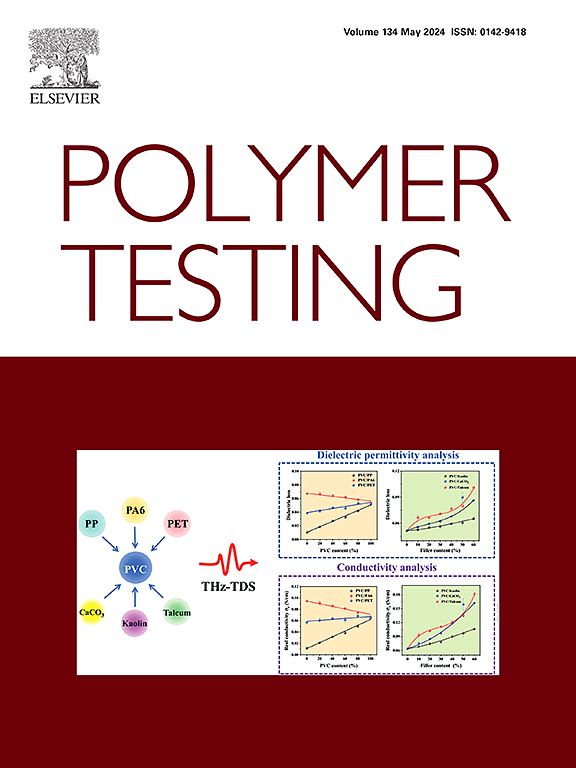离子液体/热塑性聚氨酯复合材料中基于高岭土纳米管自组装的柔性传感器
IF 5
2区 材料科学
Q1 MATERIALS SCIENCE, CHARACTERIZATION & TESTING
引用次数: 0
摘要
离子凝胶以其优异的离子导电性、热稳定性和较宽的电化学窗口逐渐进入柔性传感器领域。为了进一步的应用,平衡电离胶的机械性能和电导率是至关重要的。基于气相分离策略和自组装策略,将离子液体(IL)修饰的高岭土纳米管(HNT)添加到热塑性聚氨酯(TPU)基体中,开发了一种柔性应变传感器。作为一种相分离材料,TPU的刚性区域为离子凝胶提供了强度和韧性,而柔软区域提供了高拉伸性。由于静电相互作用,IL的阳离子和阴离子在HNT的内外表面自组装。在剪切过程中,HNT获得了有序的排列结构,为IL提供了有效的离子传输通道。作为应变传感器,TPU@IL@HNT传感器在40%应变下具有高应变因子、快速响应速度(400 ms)和良好的循环稳定性(5625个循环)。TPU@IL@HNT传感器的应变与电阻变化呈线性关系,这是其在应变传感器上应用的重要依据。总体而言,本工作制备的TPU@IL@HNT传感器可以作为可穿戴设备的优秀传感单元。本文章由计算机程序翻译,如有差异,请以英文原文为准。

Flexible sensor based on self-assembly of halloysite nanotubes in ionic liquids/thermoplastic polyurethane composites
Ionogels are gradually entering the flexible sensor field due to their excellent ionic conductivity, thermal stability and wide electrochemical window. It is critical to balance the mechanical and conductivity properties of ionogels for further application. Herein, inspired by vapor-induced phase separation strategy and self-assembled strategy, a flexible strain-sensor was developed by adding ionic liquid (IL) decorated halloysite nanotube (HNT) into thermoplastic polyurethane (TPU) matrix. As a phase separation material, the rigid regions of TPU offered strength and toughness for ionogels, while the soft regions offered high stretchability. Due to electrostatic interaction, the cations and anions of IL self-assembled onto the inner and outer surface of HNT. The HNT obtained orderly arrangement structure after shear process, which provides effective ionic transport channels for IL. As a strain sensor, the as-prepared TPU@IL@HNT sensor exhibited highly gauge factor, fast response speed (400 ms), and excellent cycle stability (5625 cycles) at a strain of 40 %. A linear relation between strain and resistance change was found for TPU@IL@HNT sensor, which is an important criterion for their application on strain sensors. As a whole, the TPU@IL@HNT sensor prepared in this work could serve as an excellent sensing unit for wearable devices.
求助全文
通过发布文献求助,成功后即可免费获取论文全文。
去求助
来源期刊

Polymer Testing
工程技术-材料科学:表征与测试
CiteScore
10.70
自引率
5.90%
发文量
328
审稿时长
44 days
期刊介绍:
Polymer Testing focuses on the testing, analysis and characterization of polymer materials, including both synthetic and natural or biobased polymers. Novel testing methods and the testing of novel polymeric materials in bulk, solution and dispersion is covered. In addition, we welcome the submission of the testing of polymeric materials for a wide range of applications and industrial products as well as nanoscale characterization.
The scope includes but is not limited to the following main topics:
Novel testing methods and Chemical analysis
• mechanical, thermal, electrical, chemical, imaging, spectroscopy, scattering and rheology
Physical properties and behaviour of novel polymer systems
• nanoscale properties, morphology, transport properties
Degradation and recycling of polymeric materials when combined with novel testing or characterization methods
• degradation, biodegradation, ageing and fire retardancy
Modelling and Simulation work will be only considered when it is linked to new or previously published experimental results.
 求助内容:
求助内容: 应助结果提醒方式:
应助结果提醒方式:


